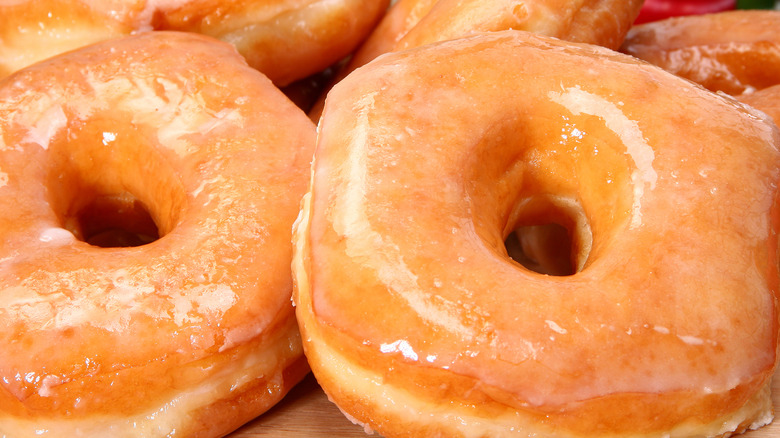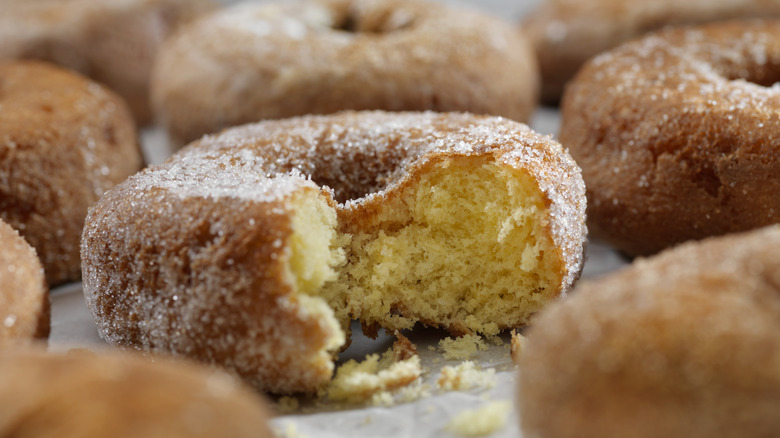The Difference Between Raised And Cake Donuts
Donuts are one of those divisive and hotly debated foods. Like Coke vs. Pepsi, deep dish pizza vs. thin crust, and crunchy peanut butter vs. smooth, people love to argue over the best kind of donut. The arguments generally boil down to the two main types — raised donuts and cake donuts — and generally hinge on texture.
Those on the side of raised donuts argue that cake donuts are too heavy and dense. They prefer raised donuts for their characteristic light texture and subtle chewiness, which comes from yeasted dough. But, for many cake donut fans, that's exactly the problem: Raised donuts aren't substantial enough. Robust and filling, cake donuts will stave off hunger pangs till lunch. They're made with baking powder as a leavener, just like your standard birthday cake. Of course, there is no answer to the debate. It all comes down to personal preference, and both types have their pros and cons.
Raised donuts are the hallmark of donut shops
Raised donuts, also called yeast donuts or just "regular" donuts, are light and fluffy with the characteristic honeycomb structure of yeasted dough. They're staples at Dunkin' Donuts and Krispy Kreme, though both chains sell cake donuts, too.
Raised donuts are made like bread. Since they employ yeast to give the dough a little extra oomph, they have to proof before being fried. If you've peeped through the glass at a Krispy Kreme location, you've seen the proofing process in action. It's the part where the donuts meander up and down through a heat-controlled box on a series of racks, rising as they go. While you don't need fancy equipment to make raised donuts at home, be warned — they're generally a bit trickier than cake donuts.
Compared to cake donuts, which come in a wide variety of flavors, raised donuts typically aren't as versatile. They have their own perks, though. The pillowy, pliable dough makes them easy to fill with jellies, creams, and custards, and you can always get creative with the toppings.
Cake donuts make for a more filling treat
While cake donuts don't melt in your mouth like raised donuts, they're heartier, easier to make, and offer more options. They can be baked in the oven and don't require proofing. Plus, it's easy to add fun flavors to cake donuts, like apple cider, red velvet, or chocolate, and they're a good option for anyone trying to make a gluten-free donut, too. They're the perfect dunking donut since the thick dough absorbs coffee or milk well. Yeasted donuts, by contrast, tend to get soggy.
Thanks to "old fashioned" donuts — a type of cake donut fried at a low temperature to form a cracked, crispy exterior — you might assume that raised donuts are some newfangled invention. Don't be fooled. "Old fashioned" donuts are a misnomer. Since chemical levelers like baking powder weren't commercially available until 1830, cake donuts are a relatively new invention. The oldest recipes for fried dough, which date back to the Roman Empire, feature yeast.
Cake donuts didn't hit the mainstream until World War I. During the war, Salvation Army volunteers served cake donuts and coffee to the troops. This endeared American servicemen to cake donuts and highlighted their dunkability. Once the war was over, cake donuts threatened to push raised donuts into extinction until chains like Krispy Kreme automated the process and popularized raised donuts once again. Now, both types are widely available, sold in trendy Brooklyn bakeries, hole-in-the-wall diners, and national chains alike.


